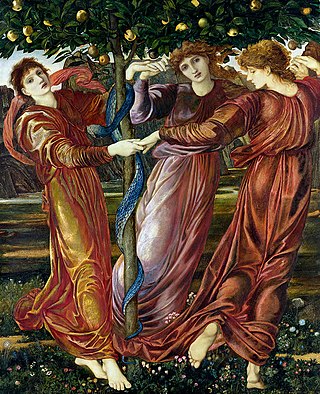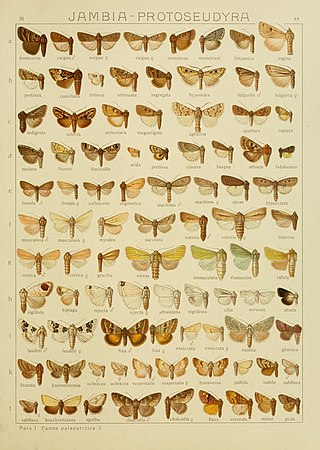
In Greek mythology, the Hesperides are the nymphs of evening and golden light of sunsets, who were the "Daughters of the Evening" or "Nymphs of the West". They were also called the Atlantides from their reputed father, Atlas.
Aegle is the name of several different figures in Greek mythology:

In Greek mythology, the Heliades also called Phaethontides were the daughters of Helios and Clymene, an Oceanid nymph.

Iaso or Ieso was the Greek goddess of recuperation from illness. The daughter of Asclepius, she had four sisters: Aceso, Aegle, Hygieia, and Panacea. All five were associated with some aspect of health or healing. For more information on the genealogy of Iaso, see Panacea.

The Noctuidae, commonly known as owlet moths, cutworms or armyworms, are a family of moths. They are considered the most controversial family in the superfamily Noctuoidea because many of the clades are constantly changing, along with the other families of the Noctuoidea. It was considered the largest family in Lepidoptera for a long time, but after regrouping Lymantriinae, Catocalinae and Calpinae within the family Erebidae, the latter holds this title now. Currently, Noctuidae is the second largest family in Noctuoidea, with about 1,089 genera and 11,772 species. This classification is still contingent, as more changes continue to appear between Noctuidae and Erebidae.

Aegle is a carbonaceous asteroid and the namesake of the Aegle family located in the outer regions of the asteroid belt, approximately 170 kilometers in diameter. It was discovered on 17 February 1868, by French astronomer Jérôme Coggia at the Marseille Observatory in southeastern France. The rare T-type asteroid has a rotation period of 13.8 hours and has been observed several times during occultation events. It was named after Aegle ("brightness"), one of the Hesperides from Greek mythology.

Aegle marmelos, commonly known as, bael, also Bengal quince, golden apple, Japanese bitter orange, stone apple or wood apple, is a species of tree native to the Indian subcontinent and Southeast Asia. It is present in India, Pakistan, Bangladesh, Sri Lanka, and Nepal as a naturalized species. The tree is considered to be sacred by Hindus and Buddhists.

Aceso or Akeso was the Greek goddess of well-being and the healing process worshipped in Athens and Epidauros.

Thésée is a tragédie en musique, an early type of French opera, in a prologue and five acts with music by Jean-Baptiste Lully and a libretto by Philippe Quinault based on Ovid's Metamorphoses. It was first performed on 11 January 1675 by the Paris Opera for the royal court at the Château de Saint-Germain-en-Laye and was first performed in public in April at the Théâtre du Palais-Royal in Paris.
Aegles was a Samian athlete, who was mute. He recovered his voice when he made an effort on one occasion to express his indignation at an attempt to impose upon him in a public contest.

Aegle is a genus of moths of the family Noctuidae.

Aegle hedychroa is a moth of the family Noctuidae. It is found in Australia.

Aegle nubila is a moth of the family Noctuidae. It is found in Turkey.

Aegle subflava is a moth of the family Noctuidae. It was described by Nikolay Grigoryevich Erschoff in 1874 and is found in Kazakhstan, Turkmenistan and Tajikistan.

The Erebidae are a family of moths in the superfamily Noctuoidea. The family is among the largest families of moths by species count and contains a wide variety of well-known macromoth groups. The family includes the underwings (Catocala); litter moths (Herminiinae); tiger, lichen, and wasp moths (Arctiinae); tussock moths (Lymantriinae), including the arctic woolly bear moth ; piercing moths ; micronoctuoid moths (Micronoctuini); snout moths (Hypeninae); and zales, though many of these common names can also refer to moths outside the Erebidae. Some of the erebid moths are called owlets.

Aegle semicana is a moth of the family Noctuidae. It was described by Eugenius Johann Christoph Esper in 1798. It is found in Austria, Italy, Hungary, former Yugoslavia, Romania, Bulgaria, Albania, Greece, Turkey, Russia, Libya, Egypt, Syria, Iraq, Iran and Israel, as well as on Sardinia, Sicily, Malta and Cyprus.
Ariadne (1932) is a short epic or long narrative poem of 3,300 lines, by the British poet F. L. Lucas. It tells the story of Theseus and Ariadne, with details drawn from various sources and original touches based on modern psychology. It was Lucas's longest poem. His other epic reworking of myth was Gilgamesh, King of Erech (1948).

Metoponiinae is a subfamily of owlet moths in the family Noctuidae. There are about 16 genera and more than 70 described species in Metoponiinae.












